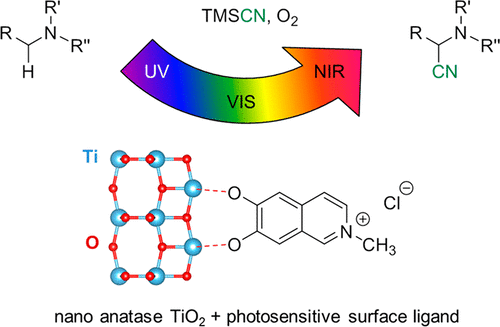当前位置:
X-MOL 学术
›
J. Am. Chem. Soc.
›
论文详情
Our official English website, www.x-mol.net, welcomes your
feedback! (Note: you will need to create a separate account there.)
TiO2 Nanoparticles Functionalized with Non-Innocent Ligands Allow Oxidative Photocyanation of Amines with Visible/Near-Infrared Photons
Journal of the American Chemical Society ( IF 14.4 ) Pub Date : 2018-09-28 , DOI: 10.1021/jacs.8b07539 Alexander M. Nauth 1 , Eugen Schechtel 2 , René Dören 2 , Wolfgang Tremel 2 , Till Opatz 1
Journal of the American Chemical Society ( IF 14.4 ) Pub Date : 2018-09-28 , DOI: 10.1021/jacs.8b07539 Alexander M. Nauth 1 , Eugen Schechtel 2 , René Dören 2 , Wolfgang Tremel 2 , Till Opatz 1
Affiliation

|
Photosynthesis is an efficient mechanism for converting solar light energy into chemical energy. We report on a strategy for the aerobic photocyanation of tertiary amines with visible and near-infrared (NIR) light. Panchromatic sensitization was achieved by functionalizing TiO2 with a 2-methylisoquinolinium chromophore, which captures essential features of the extended π-system of 2,7-diazapyrenium (DAP2+) dications or graphitic carbon nitride. Two phenolic hydroxy groups make this ligand highly redox-active and allow for efficient surface binding and enhanced electron transfer to the TiO2 surface. Non-innocent ligands have energetically accessible levels that allow redox reactions to change their charge state. Thus, the conduction band is sufficiently high to allow photochemical reduction of molecular oxygen, even with NIR light. The catalytic performance (up to 90% chemical yield for NIR excitation) of this panchromatic photocatalyst is superior to that of all photocatalysts known thus far, enabling oxidative cyanation reactions to the corresponding α-cyanated amines to proceed with high efficiency. The discovery that the surface-binding of redox-active ligands exhibits enhanced light-harvesting in the red and NIR region opens up the way to improve the overall yields in heterogeneous photocatalytic reactions. Thus, this class of functionalized semiconductors provides the basis for the design of new photocatalysts containing non-innocent donor ligands. This should increase the molar extinction coefficient, permitting a reduction of nanoparticle catalyst concentration and an increase of the chemical yields in photocatalytic reactions.
中文翻译:

用非无辜配体功能化的 TiO2 纳米颗粒允许用可见光/近红外光子对胺进行氧化光氰化
光合作用是将太阳光能转化为化学能的有效机制。我们报告了用可见光和近红外 (NIR) 光对叔胺进行有氧光氰化的策略。全色敏化是通过用 2-甲基异喹啉鎓发色团对 TiO2 进行功能化来实现的,该发色团捕获了 2,7-二氮杂芘 (DAP2+) dications 或石墨碳氮化物的扩展 π 系统的基本特征。两个酚羟基使该配体具有高度的氧化还原活性,并允许有效的表面结合和增强的电子转移到 TiO2 表面。非无辜配体具有能量可及的水平,允许氧化还原反应改变其电荷状态。因此,导带足够高以允许分子氧的光化学还原,即使使用 NIR 光也是如此。这种全色光催化剂的催化性能(近红外激发的化学产率高达 90%)优于迄今为止已知的所有光催化剂,使氧化氰化反应能够高效地进行相应的 α-氰化胺。氧化还原活性配体的表面结合在红色和近红外区域表现出增强的光捕获的发现开辟了提高多相光催化反应总产率的途径。因此,这类功能化半导体为设计含有非无辜供体配体的新型光催化剂提供了基础。这应该会增加摩尔消光系数,从而降低纳米颗粒催化剂的浓度并增加光催化反应中的化学产率。
更新日期:2018-09-28
中文翻译:

用非无辜配体功能化的 TiO2 纳米颗粒允许用可见光/近红外光子对胺进行氧化光氰化
光合作用是将太阳光能转化为化学能的有效机制。我们报告了用可见光和近红外 (NIR) 光对叔胺进行有氧光氰化的策略。全色敏化是通过用 2-甲基异喹啉鎓发色团对 TiO2 进行功能化来实现的,该发色团捕获了 2,7-二氮杂芘 (DAP2+) dications 或石墨碳氮化物的扩展 π 系统的基本特征。两个酚羟基使该配体具有高度的氧化还原活性,并允许有效的表面结合和增强的电子转移到 TiO2 表面。非无辜配体具有能量可及的水平,允许氧化还原反应改变其电荷状态。因此,导带足够高以允许分子氧的光化学还原,即使使用 NIR 光也是如此。这种全色光催化剂的催化性能(近红外激发的化学产率高达 90%)优于迄今为止已知的所有光催化剂,使氧化氰化反应能够高效地进行相应的 α-氰化胺。氧化还原活性配体的表面结合在红色和近红外区域表现出增强的光捕获的发现开辟了提高多相光催化反应总产率的途径。因此,这类功能化半导体为设计含有非无辜供体配体的新型光催化剂提供了基础。这应该会增加摩尔消光系数,从而降低纳米颗粒催化剂的浓度并增加光催化反应中的化学产率。











































 京公网安备 11010802027423号
京公网安备 11010802027423号